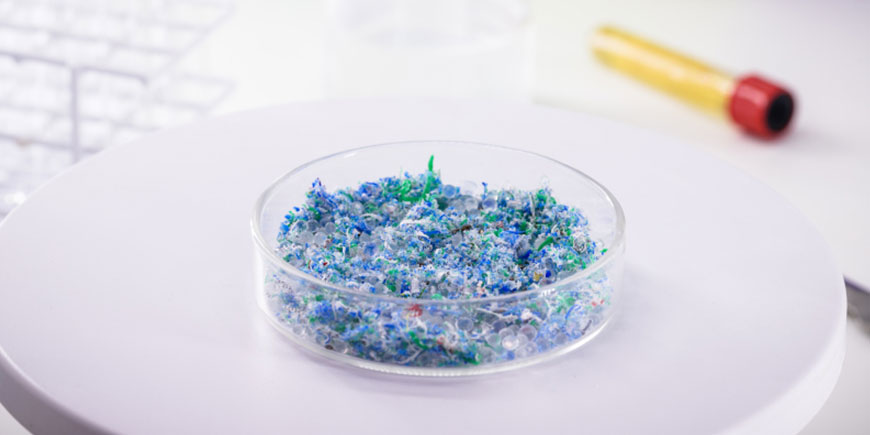A recently published review summarises the mechanisms and strategies for the removal of microplastics from aquatic ecosystems.
Microplastics pose a significant threat to aquatic and terrestrial organisms, with implications for human health. It is clear that the development of effective technologies to remove them from the aquatic environment is a research priority.
Microplastics
Microplastics are tiny pieces of plastic, usually less than 5 millimetres in size. Depending on their origin, they fall into two main categories:
- Primary microplastics:
- Released directly into the environment in the form of small particles;
- It is estimated that this category of microplastics accounts for 15-31% of microplastics in the ocean;
- Main source: washing of synthetic clothing (35% of primary microplastics);
- Tyre abrasion during driving (28%);
- Microplastics intentionally added to body care products (e.g. microparticles in facial scrubs) 2%.
- Secondary microplastics:
- Produced by the degradation of larger plastic items such as plastic bags, bottles or fishing nets;
- They make up about 68-81% of the microplastics in the ocean.
As large plastic items break down into microplastics, their abundance in the marine environment increases, which is likely to increase the potential impact on wildlife. As particle size decreases, the diversity of organisms that can ingest the debris increases. Therefore, smaller plastic particles are more likely to be ingested, increasing the risk to living organisms.

The impact on the ecosystem
The amount of microplastics in the oceans is increasing. In 2017, the UN declared that there are 51 trillion microplastic particles in the oceans, 500 times more than all the stars in our galaxy.
The ubiquity of microplastics poses a significant threat to aquatic ecosystems and, by extension, human health, as these particles are ingested by various marine organisms, including zooplankton, crustaceans and fish, and ultimately enter the human food chain.
It is estimated that each person ingests an average of 1,769 microplastics per week, totalling about 5 grams of plastic. But microplastics have also been found in food and drink, including beer, honey and tap water. So it is not surprising that plastic particles have recently been found in human faeces.
This contamination threatens the entire ecological balance, including food safety and the health of aquatic systems. The health effects are still unknown, but plastics often contain additives, such as stabilisers or flame retardants, and other potentially toxic chemicals that can be harmful to animals or humans who ingest them.

Innovative technologies to remove microplastics
A recently published review summarises the mechanisms and strategies for the removal of microplastics from aquatic ecosystems.
Strategies that combine physical and chemical pretreatment with microbial degradation have shown promise for the degradation of microplastics. Microorganisms such as bacteria, fungi, algae and specific enzymes are used in MP remediation efforts.
Recent advances have focused on innovative methods such as membrane bioreactors, synthetic biology, organosilane-based techniques, biofilm-mediated remediation and nanomaterial-based strategies, with nanomaterial-based technologies showing significant potential to increase the removal efficiency of microplastics.
There are several types of plastic breakdown:
- Photodegradation: Effect of light (usually sunlight when exposed outdoors);
- Biodegradation: Action by living organisms (microbes);
- Thermo-oxidative degradation: Oxidative decomposition at moderate temperatures;
- Thermal degradation: Effect of high temperatures; Mechanical degradation;
- Mechanical degradation;
- Hydrolysis: Reaction with water.
Photodegradation
Photodegradation, also known as photo-oxidative degradation, occurs when plastics are exposed to UV radiation and oxygen. To absorb light energy and initiate the reaction, the polymer structure of the plastic must contain unsaturated chromophore groups. However, in most cases it is not the polymer chain itself that absorbs UV light, but additives such as pigments and impurities such as catalyst residues. The intensity of UV radiation depends on many factors such as geographical location, weather and seasons. In any case, UV radiation is one of the main causes of degradation of plastics in the environment.
Biodegradation
Biodegradation is the process by which organic matter is broken down by living organisms. Organic material can be degraded by aerobiosis (in the presence of oxygen) or anaerobiosis (in the absence of oxygen). Microorganisms such as bacteria, fungi and microbes are involved in the degradation of plastics. Plastics that enter the marine environment are rapidly colonised by indigenous microorganisms, leading to the biodegradation of the material, but their biodegradation is still a slow process. In fact, plastic polymers such as PE, PP, PS, PVC and PET, are considered persistent.
Thermo-oxidative degradation
Thermo-oxidative degradation is a slow degradation. It results from oxidation at moderate temperatures.
Thermal degradation
Thermal degradation is molecular degradation caused by overheating. At high temperatures, components of the polymer chain can begin to separate (molecular scission) and react with each other to change the properties of the polymer The chemical reactions involved in thermal degradation lead to changes in physical and optical properties.
Thermal degradation leads to changes in the molecular weight of the polymer and changes in properties such as reduced ductility, chalking, colour changes, cracking and a general reduction in most other desirable physical properties. Plastics generally contain antioxidants to prevent thermal oxidation and the thermal degradation process can therefore be slow at room temperature, although each 10°C increase in room temperature results in a relative doubling of the rate of the chemical reaction. Thermal degradation can also affect the mobility of the polymer chains, which in turn affects the enzyme activity during biodegradation. As the temperature increases, the chains become more mobile, making it easier for an enzyme to bind to the correct functional group on the polymer chain.
Mechanical degradation
In the marine environment, plastic polymers can be mechanically fragmented by abrasion from sand and stones, waves or even high tides. This mechanical degradation results in the formation of smaller plastic pieces. Unlike other degradation mechanisms, mechanical degradation does not break specific chemical bonds.
Hydrolysis
Hydrolysis is the reaction of the polymer material with water. The reaction can be catalysed by acids, bases or enzymes, and is not limited to the surface of the plastic, as water can penetrate the material. In PET, for example, hydrolysis is slow due to the stabilising effect of the aromatic ring. Hydrolysis is an autocatalytic process and is much slower than photodegradation. Importantly, the oxidative and hydrolytic degradation processes lead to a reduction in the molecular weight of the polymer chains, causing the mechanical properties of the material to become more brittle. This promotes mechanical deformation and leads to the formation of nanoplastic fragments.

Conclusions and clinical relevance
Plastics are one of the most important industrial discoveries. Over time, the introduction of microplastics of various origins into aquatic ecosystems has become an increasingly significant threat to living organisms and the environment. Given the numerous harmful effects of microplastics in the environment, particularly in aquatic ecosystems, it is crucial to develop effective approaches to reduce their prevalence.
To maximise effectiveness and minimise adverse impacts, it is imperative to advance the development of microplastic processing technologies and strive to improve the quality and performance of alternatives to plastics, including bioplastics.
Strict regulations must be enforced in line with the Triple R – Reduce, Reuse and Recycle – to create material recovery facilities, promote separate collection of household waste and seek to mitigate the negative effects of microplastic pollution.


